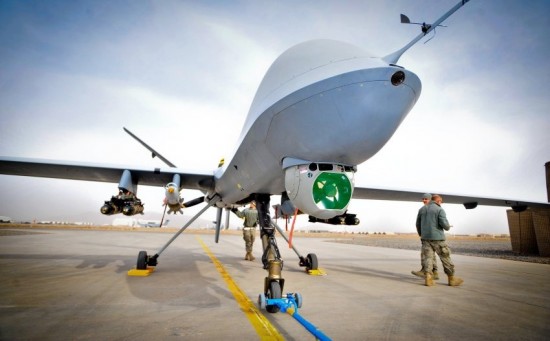The assassination of al Qa’ida’s second in command, Abu Yahya al-Libi, by a remote controlled CIA Reaper drone is the most recent in a history of killings by these machines in Pakistan’s North West province.
In the past eight years CIA drones have killed more than 2400 people in Pakistan, including as many as 800 civilians, according to figures on the website of The Bureau of Investigative Journalism, an independent news organisation based in London.
Pakistan has received more than $11 billion in aid from the US in the last ten years and is nominally an American ally and its partner in “The War Against Terror”. However it has been consistently sheltering al Qa’ida and Taliban operatives at great cost to the NATO allies, and the alliance has been very shaky since NATO took out a Pakistani Army location last year, thinking it was a Taliban stronghold.
And since the imprisonment by Pakistan on May 23 of the doctor who helped the Navy Seals locate Bin Laden, the US has launched more than eight drone strikes in Pakistan, including the one that killed Abu Yahya al-Libi, described by an American spokesman as a devastating and unrecoverable blow to al Qa’ida’s senior leadership.
Unmanned aerial vehicles are in themselves scary enough, raising questions about the ethics of the changing nature of warfare. But they represent the most visible examples of a rapid and sweeping change in a wider context – the beginning of robotic warfare.
Devices in development and test deployment by America and Europe include: unmanned ground vehicles that can defuse bombs; robots that can track and attack people based on individual biometric data; machines that can climb up a vertical wall, enter a window, and send a picture of the room to the operator (who can then deploy a built-in gun); small (almost undetectable) flying video cameras, and smart hand grenades on miniature wheels.
After all, war has always been the greatest driver of technological development and the huge advances in communications, IT and mechanical devices that are a feature of the cybernetic age are beginning to be deployed on the battlefield. Remember the Internet was developed by DARPA, an advanced US military research organisation.
But at the moment these devices are all controlled by remote operators, usually at the CIA headquarters in Washington. The next step, however, is when it will get really frightening: robot weapons will act autonomously, either in conflict with other robot weapons or attacking human combatants, or targeting specific individuals for corporate, political or strategic ends.
The ethical behaviour of robots has long been an obsession of science fiction writers and is now transforming into an actual science. Should a robot be able to harm a person? Isaac Asimov’s famous Three Laws of Robotics sets out trite rules so that his robots devote most of their energy trying to deal with the contradictions that these give rise to.
And they are not a good model for autonomous killing machines, particularly when the ethics of war as waged by plain old humans is such a grey area anyway. The term “Thinking Machine” is still very much an oxymoron, much like “Military Intelligence”.
Still, the deployment of this gear is inevitable, for the same reason that robots are rapidly replacing humans in many areas of the workforce. They are cheap, accurate, reliable and don’t need breaks – and nobody is bereaved if they are broken or destroyed. And it sidesteps the political problem of your boys coming home in a box.
It does cause a lot of problems in Pakistan and other target populations though.
The prolific writer Phil K Dick, probably most famous for the film scripts of Total Recall, Blade Runner, and The Minority Report, wrote many stories about robots and androids. One of his most chilling short stories is Second Variety. Written in 1953, it describes a world almost destroyed by nuclear weapons and warfare, where the autonomous subsurface factories of the East and West continue to produce and develop more and more sophisticated killing machines that eventually begin to destroy one another and render the few humans that survive irrelevant.
And although our future is more likely to be an environmental dystopia than Dick’s nuclear nightmare, his satire is in danger of becoming an aspect of our reality.






Nice piece and extremely scary stuff!